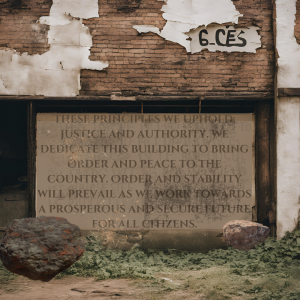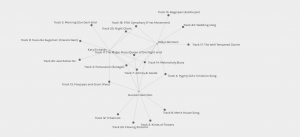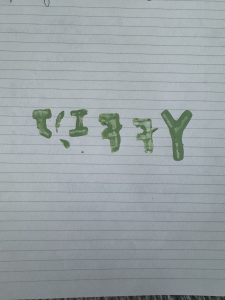Speculative Narrative Prompt:
Describe or narrate a scenario about a building found a millennium into a future in which order is deliberately coordinated or imposed. Your description should address issues related to disease and elicit feelings of fervor.
It’s Monday, July 31st, 3024. A group of archeologists is exploring an area of what was previously known as North America…
Over the last few centuries, sea levels have impacted the area significantly, with many buildings and cities being decimated. Globally, the impact of climate change has been catastrophic. Extreme weather patterns such as droughts and floods have reduced the biodiversity available. The resulting food and resource scarcity has forced the remaining global populations to relocate. A large part of the population was eradicated by viruses and diseases that ravaged human, animals as well as flora and fauna. There was a dark period of wars fought over resources that ultimately resulted in societies and governments being restructured – there is now one global governing body, a singular global crypto currency, and a military group known as the Galba Unit. The Galba have limited human soldiers, but a vast fleet of humanoids, drones, laser weapons, and autonomous military vehicles to help them carry out their intense surveillance of the remaining populations.
The building is a vast structure that spans a large area in the center of the former metropolis. The building, once gleaming white, is covered in spray paint and many of the towers have been reduced to rubble in the wars. As the archeologists step inside, they can see on the walls the credo which reads “These principles we uphold: justice and authority. We dedicate this building to bring order and peace to the country. Order and stability will prevail as we work towards a prosperous and secure future for all citizens”.

As the archeologists explore the building, they uncover endless surveillance rooms, with some remaining electronic equipment strewn about, badly damaged from the raids. Some of the rooms are great halls, with seats surrounding a central speaking area. None of the rooms have any windows, and they are adorned with several locking and security mechanisms at the doors. The building has wards dedicated to sanitization, full of biomedical equipment, PPE and medication vials, some still intact. There are robotic operated medical equipment machines throughout, and refrigerated rooms for storing what was once a large supply of vaccines. Now, the building tells stories of a time of turmoil and desperation…
Reflection:
I hope you enjoyed my narrative as much as I enjoyed creating it. I opted to let my imagination go a little wild and included a wide variety of possible future social problems and/or challenges. As Petra Lilja (2021) notes “speculative design, or any related design approach oriented towards the future is to use it as a vehicle to approach complex societal and environmental challenges through design” (p.39). The future I envisioned is dystopian, but my goal was to provide some commentary on the issues of contemporary society and how that might pan out.
Mitrović, I., Auger, J., Hanna, J., & Helgason, I. (Eds.). (2021). Beyond speculative design: Past – present – future. SpeculativeEdu.







